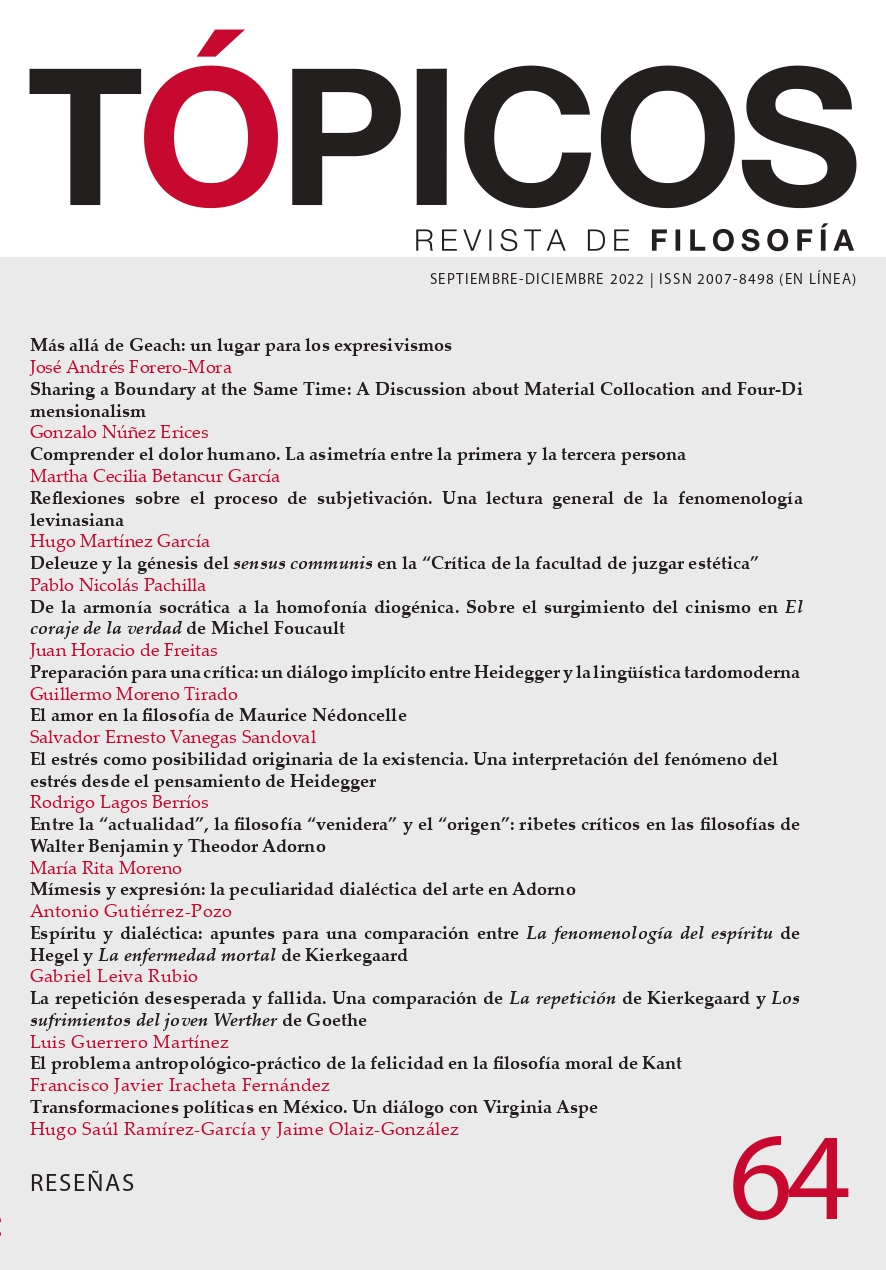Publicado 2022-08-13
Palabras clave
- existencia inauténtica,
- subjetividad,
- seudónimos,
- construcción imaginativa
Derechos de autor 2022 Tópicos, Revista de Filosofía

Esta obra está bajo una licencia internacional Creative Commons Atribución-NoComercial-SinDerivadas 4.0.
Cómo citar
Resumen
Una de las categorías filosóficas más complejas y al mismo tiempo más importantes en el pensamiento de Kierkegaard es la “repetición”, a la cual dedicó una de sus primeras obras seudónimas: La repetición, del seudónimo Constantin Constantius. Este artículo, en primer lugar, explora el concepto de “repetición desesperada y fallida” que juega un papel importante en la ironía kierkegaardiana. En segundo lugar, muestra algunos aspectos paralelos que se encuentran en La repetición y en la novela de Goethe, Los sufrimientos del joven Werther; esta conexión permite una mejor comprensión de ambas obras respecto a la desesperación asociada a una repetición fallida.
Referencias
- Fuentes primaris
- Goethe, J. W. (1951). Goethes Werke in Zwei Bänden. Die Berland-Buch-Klassiker.
- Goethe, J. W. ((1972). Fausto. J. Roviralta Borrell (trad.). W. M. Jackson.
- Goethe, J. W. ((1982). Werther. J. Valor (trad.). Salvat Editores.
- Goethe, J. W. ((2009). Obras completas. Tomo II. R. Cansinos Asséns (trad.). Aguilar.
- Kierkegaard, S. (1997-2013). (SKS). Kierkegaards Skrifter. 55 Volúmenes. N. Jørgen Cappelørn, J. Garff, J. Kondrup, A. McKinnon y F. Hauberg Mortensen (eds.). Søren Kierkegaard Forskningscenteret ved Københavns Universitet-Gad.
- Kierkegaard, S. (2006). O lo uno o lo otro. Un fragmento de vida. I. B. Saez Tajafuerce y D. Gonzalez (trads.). Trotta.
- Kierkegaard, S. (2007). El concepto de la angustia. D. Gutiérrez Rivero (trad.). Alianza.
- Kierkegaard, S. (2008). Postscriptum no científico y definitivo a Migajas filosóficas. N. Bravo Jordán (trad.). Universidad Iberoamericana.
- Kierkegaard, S. (2009). La repetición. D. Gutiérrez Rivero (trad.). Alianza.
- Kierkegaard, S. (2017). Diarios. Volumen V. 1842-1844. N. Bravo Jordán (trad.). Universidad Iberoamericana.
- Fuentes secundarias
- Binetti, M. J. (2008). Mediación o repetición: de Hegel a Kierkegaard y Deleuze. Δαíμων. Revista de Filosofía, 45, 125-139.
- Burgess, A. J. (1993). Repetition–A Story of Suffering. En R. L. Perkins (ed.), Fear and Trembling and Repetition. (pp. 247-262). International Kierkegaard Commentary. Mercer University Press.
- Carlisle, C. (2005). Kierkegaard’s Philosophy of Becoming. Movements and Positions. State University of New York Press.
- Dobre, C. (2014). Søren Kierkegaard y la reconstrucción de la filosofía mediante la duda subjetiva y la repetición a partir del escrito De omnibus dubitandum est. Tópicos, Revista de Filosofía, 47, pp. 25-52. DOI: https://doi.org/10.21555/top.v0i47.661.
- Edmunds, K. (1996). “Der Gesang soll deinen Namen erhalten”: Ossian, Werther and Texts of/for Mourning. Goethe Yearbook, 8, 45-65.
- Garff, J. (2005). Søren Kierkegaard. A Biography. B. H. Kirmmse (trad.). Princeton University Press.
- Gouwens, D. J. (1993). Understanding, Imagination, and Irony in Kierkegaard’s Repetition. En R. L. Perkins (ed.), Fear and Trembling and Repetition. (pp. 283-308). International Kierkegaard Commentary. Mercer University Press.
- Guedes Rossatti, G. (2015). Constantin Constantius: The Activity of a Travelling Esthetician and How He Still Happened to Pay for the Dinner. En J. Stewart y K. Nun (eds.), Kierkegaard’s Pseudonyms. (pp. 51-66). Ashgate.
- Heiberg, J. L. (1844). Det astronomiske Aar. Urania. Aarbog for 1844, 77-160.
- Hong, H. V. y Hong, E. H. (1983). Historical Introduction. En S. Kierkegaard, Fear and Trembling. Repetition. (pp. IX-XXXIX). Princeton University Press.
- Horacio. (1847). Odas. J. Escriche (trad.). Imprenta de Alejandro Gómez Fuentenebro.
- Mooney, E. F. (2017). On Søren Kierkegaard: Dialogue, Polemics, Lost Intimacy, and Time. Routledge.
- Muenzer, C. S. (1984). Figures of Identity: Goethe’s Novels and the Enigmatic Self. Penn State University Press.
- Platón. (1999). Diálogos. II. Gorgias, Menéxeno, Eutidemo, Menón, Crátilo. J. Calonge Ruiz, E. Acosta Méndez, F. J. Olivieri, J. L. Calvo (trads.). Gredos.
- Poole, R. (1993). Kierkegaard: The Indirect Communication. University of Virginia Press.
- Stewart, J. (2015). The Cultural Crisis of the Danish Golden Age. Heiberg, Martensen and Kierkegaard. Museum Tusculanum Press.
- Stewart, J. y Nun, K. (2008). Goethe: A German Classic Through the Filter of the Danish Golden Age. En J. Stewart (ed.), Kierkegaard and his German Contemporaries: Literature and Aesthetics. (pp. 51-96). Ashgate.
- Sullivan, H. I. (2007). The Dangerous Quest for Nature Narratives in Goethe’s Werther: A Reading of the Ruptured Monologue and the Ruptured Body. Interdisciplinary Studies in Literature and the Environment, 14(2), 1-23.
- Valadez, L. (2018). Samsagaz Gamgy. Una lectura de El señor de los anillos desde la repetición kierkegaardiana. Estudios Kierkegaardianos. Revista de Filosofía, 4, 115-146.





